If you’ve only got 5 days in Portugal and looking to make the most of it, you’ve come to the right place! Portugal has incredible scenery, picturesque historic streets, plenty of intricate azulejo tiles, vibrant culture, incredible food (hellooooo seafood and egg tarts), and plenty more to love. You won’t see it all in Portugal in 5 days, but it’s enough to help you fall in love!
And the thing is – I haven’t even begun to scratch the surface in exploring what the country has to offer. A 5 day Portugal itinerary is ambitious – you won’t be able to see it all. But it is enough time to make you fall in love and leave you wanting to come back for more.
Spending 5 days in Portugal is better than spending no days in Portugal. And if that’s all you can swing (that was all the PTO I could spare when I went), then hey, you gotta work with it. And I’m here to show you exactly how!
A Portugal itinerary for 5 days is enough time to explore its two largest cities – the vibrant capital city of Lisbon and beautiful Porto in the north. You’ll also get to take a day trip to Sintra, full of extravagant forest and dewy forests.
If you’re anything like me, you’ll fall head-over-heels in love and come home wanting to plan another trip back to Portugal ASAP because there’s so much more left to see on your bucket list.
In the meantime – here’s the perfect Portugal 5 day itinerary to help you plan the perfect trip!
**This post contains affiliate links. This means that if you make a purchase or booking, I may receive a small commission at no additional cost to you. Pictures & Words is a participant in the Amazon Services LLC Associates Program, an affiliate advertising program designed to provide a means for us to earn fees by linking to amazon.com and affiliated sites at no cost to you.
Planning a trip to Portugal? If you’re headed to Portugal soon and short on time, here are my top picks for the perfect trip!
Best Things to Do in Lisbon:
- Jeronimos Monastery skip-the-line ticket
- Lisbon: History, Stories, and Lifestyle Walking Tour
- Fado Show and Portuguese Dinner
- Lisbon: Old Town Tuk Tuk Tour
Save money in Lisbon: The Lisboa Card includes entry into 51 of the top attractions in Lisbon, as well as free transport, and other special offers. You can choose from a card valid for 24, 48, or 72 hours.
Top Tours + Attractions in Sintra:
- Sintra Highlights Tour
- Pena Palace skip-the-line ticket
- Castle of the Moors
- Quinta de Regaleira
- Montserrate Palace
Best Things to Do in Porto:
- Six Bridges Cruise
- Porto: Historic City Center Walking Tour
- Calem Cellar Tour + Tasting
- Clerigos Church + Tower skip-the-line ticket
Booking your train tickets on Omio: The CP rail site is notorious for being confusing and finicky when it comes to using foreign credit cards. By using Omio, it streamlines the booking process, avoiding the language barriers and/or credit card issues. It also saves all of your tickets in the app, with offline access, which is super handy!
Need a rental car? Book on rentalcars.com, which allows you to compare prices from the top car rental companies and offers a price match guarantee.
Things to Know Before Your 5 Days in Portugal Itinerary


An overview of this 5 day Portugal itinerary
This Portugal itinerary for 5 days visits its two major cities, with a day trip to see the palaces of Sintra. It assumes that you have five full days, and does not include travel time to and from Portugal.
It covers the following:
- 2 days in Lisbon
- A day trip to Sintra
- 2 days in Porto
I designed this itinerary to start in Lisbon since this is where most international flights arrive, however you can also complete it in reverse if that is more convenient for you.
You might be thinking of adding on this 5 day Portugal itinerary along with a Spain itinerary, which is an excellent idea! The two countries are right next to each other, and many people plan a combined Spain and Portugal itinerary.
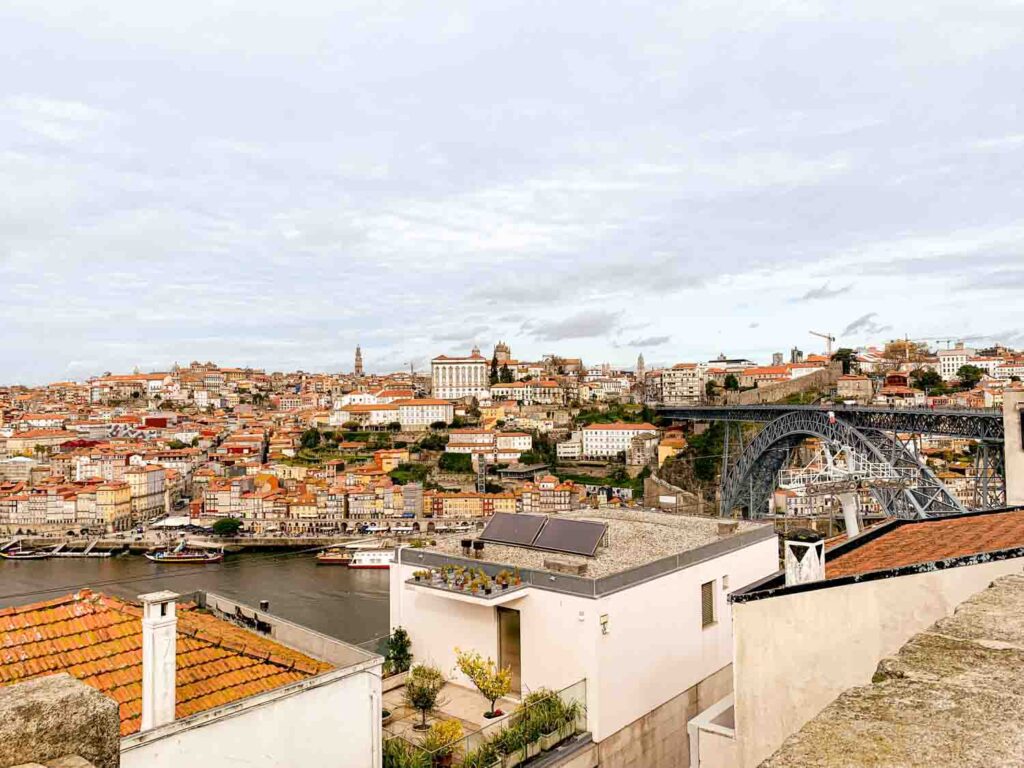
How many days do you need in Portugal – is 5 days enough?
No, you’re definitely not going to see or do everything in Portugal in 5 days. Not even close!
Five days in any country is highly ambitious, and you won’t be able to see it all in that short period of time (well, unless it’s a tiny country like Singapore). And while Portugal is considered to be relatively small, it has soooo many incredible sights and landmarks. So no, 5 days isn’t enough at all.
Heck, you can easily spend 2 weeks in Portugal and still not see and do it all!
But…5 days in Portugal is better than no days in Portugal! It will give you just enough time to see Lisbon and Porto, its two largest cities, along with the fairytale town of Sintra. You’ll get a taste of some of the best of what Portugal has to offer – and hopefully will leave you wanting to come back for more!
I only had enough PTO for a 5 day trip to Portugal, and planned out a Lisbon and Porto itinerary, which includes a day trip to Sintra, which is the exact one that I’m sharing here! It definitely was enough time to help me fall in love with the country – although there were soooo many more places that I definitely am planning a return trip because there’s so much more left on my Portugal bucket list!


When to visit Portugal
Portugal experiences a mild Mediterranean climate, meaning that there’s really no *bad* time to spend 5 days in Lisbon and Porto. The country experiences relatively mild temperatures year-round, making it ideal to visit at any time of year.
Do note that the northern part of the country (Porto) is a bit cooler than in the southern areas of the country (Lisbon). While this might mean that the weather is much more pleasant in Porto in the summer, keep in mind that it can get a bit chilly in the winter months.
I planned my 5 day trip to Portugal in late November over Thanksgiving week and found that the weather in Lisbon was still pretty mild and wished I hadn’t packed so many sweaters. However, once I got to Porto, it was a bit chilly and rained a little bit, and I was glad I’d packed warm layers!
In any case, here’s a rundown of what to expect when spending planning a Portugal 5 day itinerary at different times of the year:

Summer (June-September)
Portugal has a reputation for having hot summers (much like in the cities of southern Spain, like Seville and Granada). You’ll find that this pretty much rings true – in the southern part of the country at least. This is especially true in July and August.
While Lisbon can get pretty hot in the summer, with highs averaging in the mid 80s Fahrenheit, you’ll find that the temperatures are much cooler in Porto, which experiences highs in the mid 70s Fahrenheit.
If hanging out at the beach, enjoying a drink on a rooftop terrace, or attending an outdoor festival sounds good to you, then summer is probably your best bet for spending 5 days in Portugal.
However, do note that summer is Portugal’s high season, and you’ll see the crowd levels, flight and train fares, and accommodation prices to reflect that. You’ll also want to book your attraction tickets well in advance, as they tend to sell out.
Spring + Fall (March-May, October-mid November)
These months are considered to be Portugal’s shoulder season and an ideal time to visit, especially if you want to avoid crowds. Crowds thin out considerably before and after the summer months, and prices for flights and accommodations also come down.
In my opinion, May and late September to early October are the best months to visit. This is because the crowds thin out but the weather is still warm to take advantage of outdoor activities in Portugal.
Early spring and fall still experiences relatively warm temperatures during the day, but it gets a bit chilly at night. If you visit during those months, be sure to bring a jacket!


Winter (late November-February)
Portugal is known for its mild winters, and many Europeans from colder climates flock there to escape the cold. However, the weather can be a bit unpredictable.
Still, it’s not necessarily a bad time to visit, as you’ll escape the crowds. And even though Portugal experiences the chilliest temperatures during these months, especially in the north (where Porto is), the highs still hover around 58°F, and lows rarely fall below 40°F.
If you’re visiting during the winter months, be prepared for rain, particularly in Porto. While it did rain a little bit when I visited in late November, it did not hinder my ability to explore Portugal in 5 days.
However, in planning a return trip to Portugal, I would personally not visit during winter again.
Traveling to Portugal

Flying to Portugal
The best and most convenient way to arrive in Portugal is via plane. Portugal has two main international airports, in Lisbon (LIS) and Porto (OPO).
Lisbon’s Humberto Delgado Airport is the country’s main international hub, so if you’re coming from outside of Europe, this will be your best option for finding flights.
Coming from the United States, you’ll find that most direct flights depart from major cities on the east coast (i.e. New York City, Boston, Washington DC). If you’re coming from the west coast (like me!), you’ll likely have to connect in one of these cities, or somewhere in Europe. There are a handful of direct flights from the west coast operated by TAP Air Portugal, but they are usually seasonal and only operate on certain days of the week.
Flights tend to be expensive during the summer months, and run well over $1000. Outside of these times, you can find some deals! When I visited over Thanksgiving week, I found a $400 flight departing from San Francisco (where I lived at the time) – a steal!
Another option is to fly into the Francisco Sá Carneiro Airport in Porto. This airport serves mainly domestic and European flights. I wouldn’t necessarily recommend flying directly to Porto if coming from the United States as the flights to Lisbon tend to be cheaper and more convenient, but it might be a good option if you’re coming from elsewhere in Europe.


Taking the train to Portugal
Traveling to Portugal via train isn’t exactly the most convenient method, as there are only limited trains and they take a long time. While I love taking trains around Europe, I’d honestly recommend flying over taking a train to Europe.
If you choose to travel to Portugal via rail, there is one daily direct train running from Madrid to Lisbon. There is also a second route that connects Porto with Virgo, a city in Northwestern Spain, near the Portuguese border.


Taking the bus to Portugal
Taking an intercity coach bus is also an option for traveling to Portugal, particularly if you are traveling from Spain.
You can travel from Seville to Lisbon by bus, which takes about 7 hours. Another option is to take a bus from Madrid to Porto – this takes anywhere between 8.5-10 hours, depending on the route you take.
FlixBus is a popular option for traveling around Europe via bus. You can also book a bus via a number of other bus companies, including Alsa, Renex, and Rede Expressos – for these, I recommend booking through Omio.
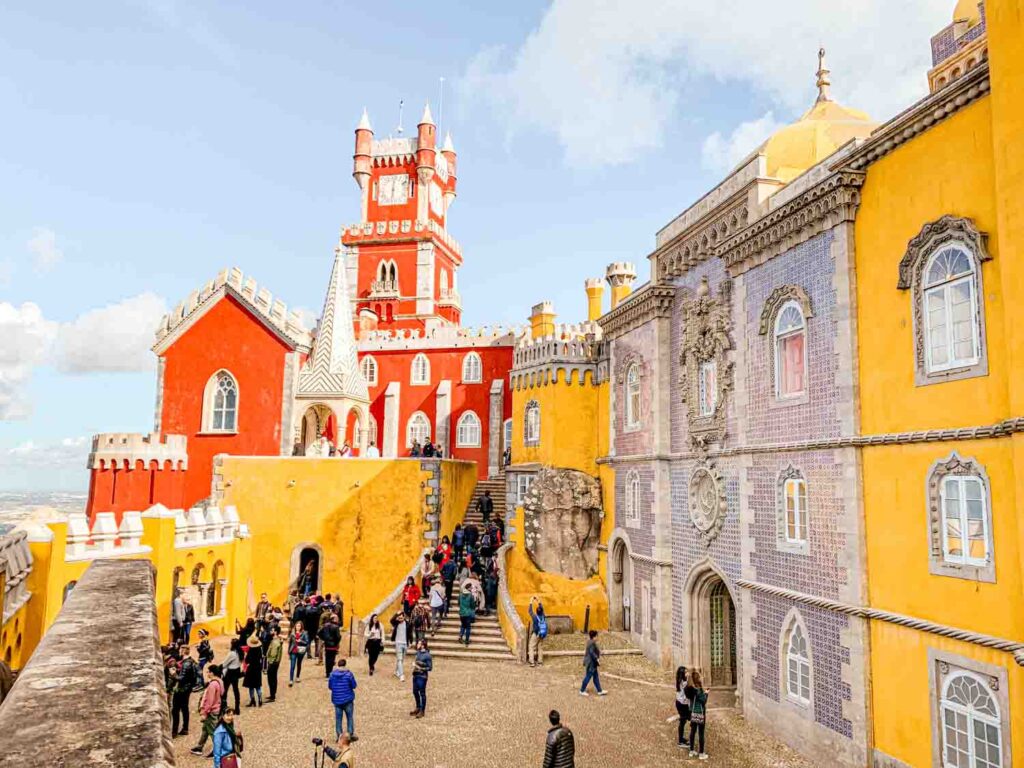
Driving to Portugal
It is relatively easy to drive to and between cities in Portugal, and the country is a popular road trip destination. The highways are well maintained and the signage is easy to follow. If you are traveling from neighboring countries such as Spain, you might be thinking about doing a road trip in Portugal.
However, it can be a pain in the butt to drive once you are *in* the cities, as all of the cities included in this Portugal 5 day itinerary tend to be hilly, with narrow roads. Traffic and parking woes tend to be a problem as well.
I’d advise against driving during this Portugal itinerary for 5 days, as having a car really is not necessary. You will only have time to see the major cities in Portugal, and you can easily travel between all the destinations with public transportation.
Plus, once you’re in the cities having a car will be more of an annoyance than convenient – and with limited time, you won’t need it at all!
Getting around during your Portugal 5 day itinerary


By Train
Portugal’s cities are relatively well-connected via high-speed rail, and it is an excellent way to travel during your 5 day Portugal itinerary.
The country’s rail network is operated by CP (Comboios de Portugal), and includes both high-speed AP (Alfa Pendular) trains, intercity IC (Intercidades), and regional trains.
If you can, take the high-speed AP trains to travel between Lisbon and Porto. While this might be a tad more expensive, the trains travel at speeds up to 220 km (135 miles) per hour, and getting around will be a breeze! They were super comfortable and fast, with WiFi and power outlets as well.
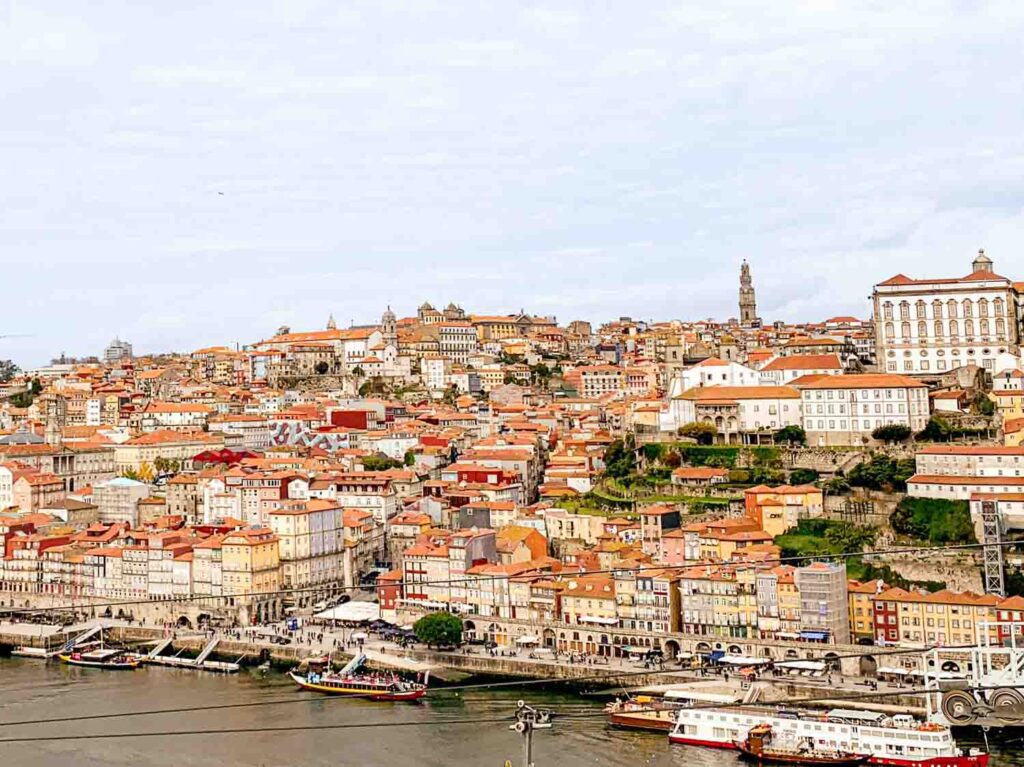
When booking your train tickets, I highly recommend booking through Omio. The CP site is notorious for being confusing and finicky when it comes to using foreign credit cards. By using Omio, it streamlines the booking process, avoiding the language barriers and/or credit card issues. It also saves all of your tickets in the app, with offline access, which is super handy!
You’ll pay a small convenience charge to use the service, but I thought it was well worth it to avoid all the hassle and headache of figuring out the CP site!
Be sure to book your train tickets in advance, as they sometimes do sell out during peak times. You will also save some money if you book at least 5 days in advance.
You’ll also find yourself taking regional trains during your Lisbon and Porto itinerary, particularly when taking your day trip to Sintra, and to get to Belem. This is relatively straightforward, and you can buy your tickets on the day of. I will explain in more detail how exactly to take the regional trains later on in this Portugal itinerary for 5 days.


By Plane
You can also fly between Lisbon and Porto. There are plenty of flights throughout the day operated by TAP Portugal Air, which take about an hour.
However, taking the train in Portugal is so relaxing and easy that I’d recommend it over flying. The train from Lisbon to Porto takes around 3 hours; by the time you factor in the time getting to and from the airport, going through security, and the flight itself, it takes more time than taking the train!
Plus taking the train is much less stressful than having to travel through busy airports. Trust me – taking the train during your Portugal 5 day itinerary is the way to go!


By Car
While a Portugal road trip is pretty popular, I wouldn’t necessarily recommend it for this itinerary. The beauty of a road trip is to make stops at all the cool places in between destinations, and you’ll just be too rushed when you’re trying to see Portugal in 5 days.
Besides, it’s so easy to get around the country via train that it really isn’t necessary to drive – nor would you want to once you actually get to the cities. The destinations included on this itinerary tend to have hilly and narrow roads, and along with the parking and traffic woes, having a car just becomes an annoyance.
A few more tips for your 5 days in Lisbon and Porto


Language
Portuguese is the official language of Portugal.
It’s kinda sorta similar to Spanish, but also not similar at all (also, the official language is not Spanish, which you’d think doesn’t need mentioning, but ya know…)
I was pleasantly surprised at the amount of people who spoke English, especially in Lisbon. Since I don’t speak that much Portuguese at all, aside from knowing a few basic phrases, this was very helpful!
While I got around mostly speaking English during my Lisbon and Porto itinerary, it is still helpful (and very much appreciated by locals) to know a few basic Portuguese words and phrases –
- Olá: hello
- Adeus: goodbye
- Obrigado: thank you
- Por favor: please
- Sim: Yes
- Não: No
- Bom dia: Good morning
- Boa tarde: Good afternoon
- Boa noite: Good evening
- Eu não falo português: I don’t speak Portuguese
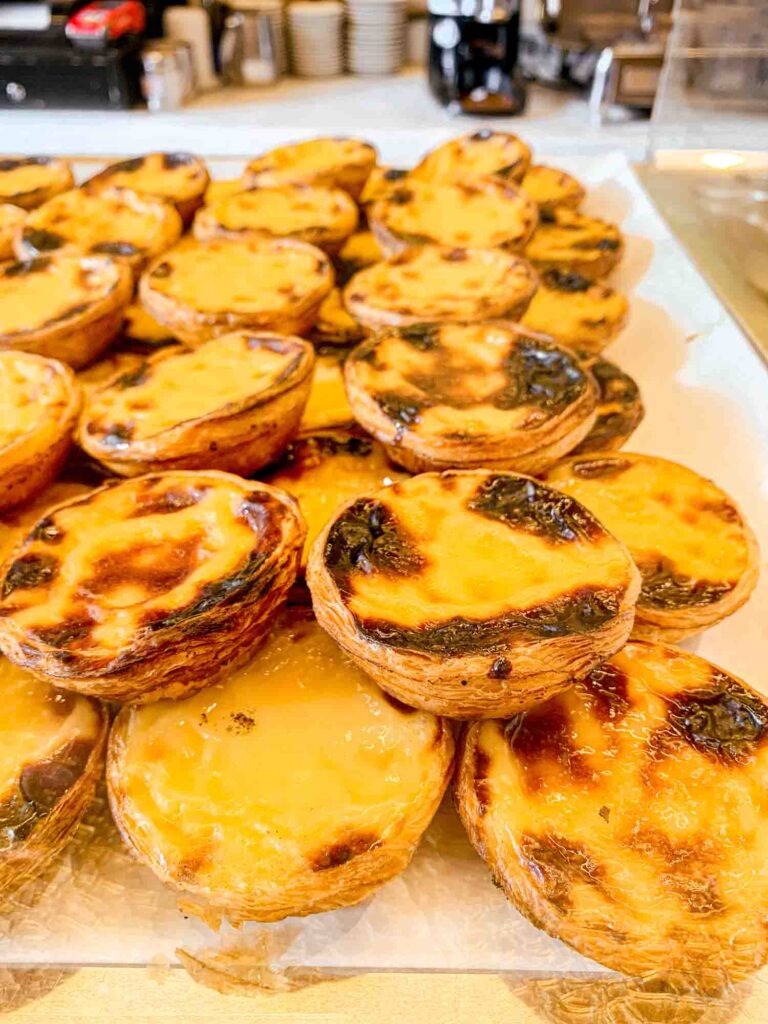


Currency, Money, and Tipping
Portugal’s official currency is the Euro, like in much of the EU.
I found that most establishments accepted credit cards, although there were a few instances where I had to use cash (smaller bakeries/cafes, train stations, small shops, etc).
Therefore, it is a good idea to take out a little bit of cash upon arrival in Portugal. You won’t need a ton, but you’ll want to have a little bit for these smaller transactions (I took out 200 Euros). I usually take out cash at an airport ATM upon arrival in a country, and I did so as soon as my flight landed in Lisbon. Always get cash from an ATM instead of a currency exchange counter, as they provide much more favorable rates.
Prior to my 5 day trip to Portugal, I was a bit worried because I kept reading various sources online mentioning that many establishments would only accept credit cards if they had a PIN, which is not a common practice with US cards. However, once I got to Portugal, I was relieved to find out that this was not the case and was able to use my credit card normally.
Tipping isn’t mandatory in Portugal, but sometimes is expected in tourist-frequented restaurants, or upscale eateries. In this case, you can leave 5-10% for good service, or round up the bill (for example, leaving €40 on a €37 bill). Also double check to see that the restaurant hasn’t already added a service charge.
Portugal is considered to be one of the most affordable countries in Western Europe, and while prices are inching up a bit due to its popularity, I found this to be especially true (especially coming from expensive California). This is especially true in Porto, which is one of the most affordable cities in Europe!
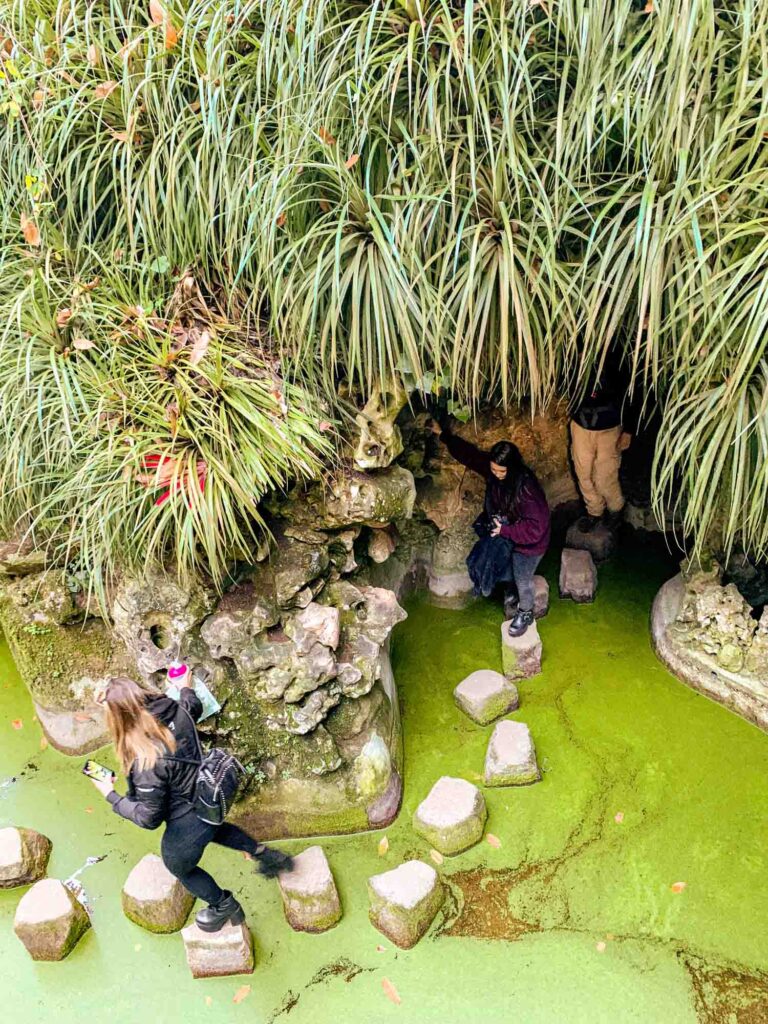

Safety in Portugal
Portugal has a reputation for being one of the safest countries in Europe, and there’s a reason why it’s considered to be one of the best countries to visit for solo female travelers.
I traveled solo during my 5 days in Portugal, and never felt unsafe once!
While violent crime is extremely rare in Portugal, petty crimes and theft are unfortunately common, especially in touristy places in Lisbon. Always keep a close watch on your belongings, especially in crowded areas! Never leave your belongings unattended, leave your valuables in the hotel safe, and don’t make yourself an easy target for thieves. Don’t leave your bag on the floor, or your phone on the table when eating at an outdoor restaurant.
I also recommend carrying a cross-body bag, or even an anti-theft purse.
It is always smart to exercise basic safety precautions, wherever you are in the world. Some of these guidelines to keep in mind include:
- Don’t walk around late at night, or by yourself
- If you’re out at night, walk around well-lit places where there are people
- ALWAYS be aware of your surroundings!
- Don’t carry around valuables
- Don’t go off with strangers
- Don’t get super drunk
- Always let someone at home know where you’ll be at all times and give them a copy of your itinerary
What to pack for your 5 day trip to Portugal
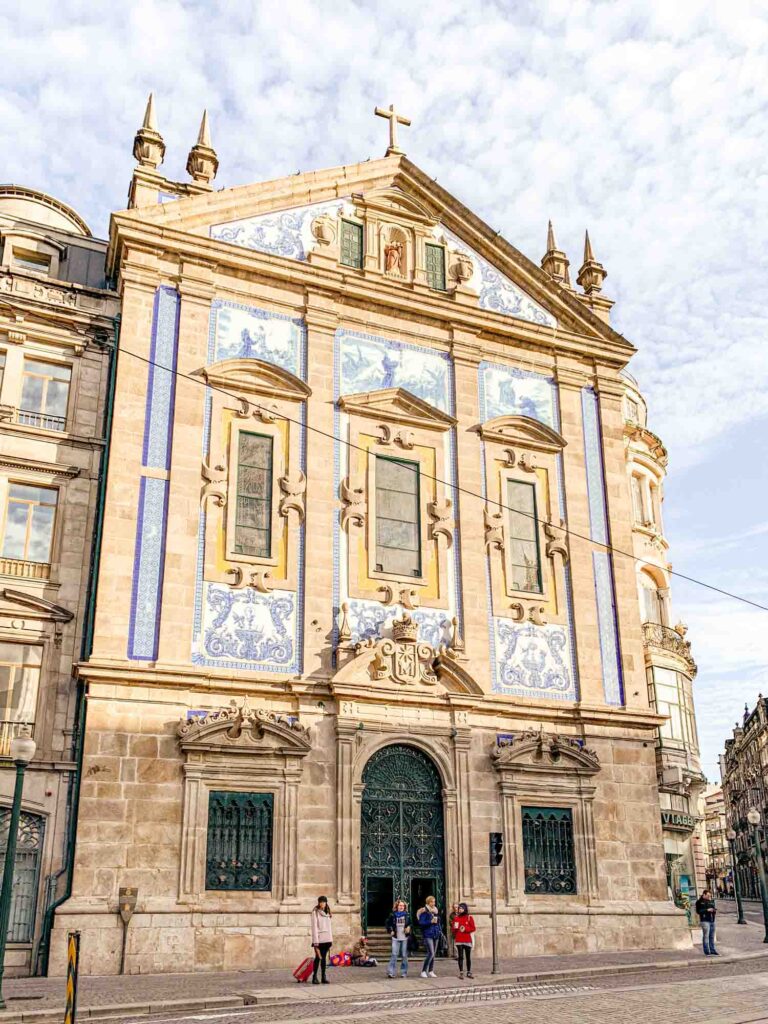

Here are some helpful items to pack for your 5 day Portugal itinerary:
- Comfortable walking shoes: You’ll do a LOT of walking during your five days in Portugal, up gnarly hills and through cobblestoned streets! My favorite travel sneakers are from Allbirds, and my favorite travel flats are from Rothy’s. For warmer months, I also love these sandals from Crocs – which are super comfy and stylish, I swear!
- Light jacket: It gets a bit breezy at night, even during warmer months.
- Rain jacket: Especially so if you’re spending 5 days in Lisbon and Porto during shoulder season/low season.
- Power adapter: If you are coming from the United States, you will need a power adapter to plug in your devices. This one is the one I travel with and has multiple ports for plugs and USBs.
- Portable phone charger: Keep your phone and other devices charged while you’re out and about – all that navigating and photo-taking really does drain the battery quickly.
- Reusable water bottle: You’ll want to make sure to stay hydrated as you walk around the city during your two days in Stockholm. Another thing to keep in mind is that in Europe, there is usually no free tap water at restaurants, and will have to pay for bottled water.
- Sunscreen: The sun gets pretty intense in Portugal especially in summer, so don’t forget the SPF! Also, here’s my favorite face sunscreen (and a top off).
The Perfect Portugal Itinerary: 5 Days

Portugal Itinerary Days 1-2: Lisbon
Time to kick off your Portugal itinerary for 5 days! You’ll spend the first two days in the beautiful capital city of Lisbon.
Lisbon is full of charming cobblestone streets, pastel-colored buildings, and azulejos tiled facades. It’s quite hilly, but that just means you’ll find spectacular views throughout the city, particularly from one of its many miradouros (or viewpoints).
It’s also a city with a rich history (did you know Lisbon is older than Rome? One of the coolest facts about Portugal), plenty of cool street art, and an incredible food scene.
Spending two days in Lisbon will allow you to experience its charm, and see all of its highlights – from its historic monuments, getting lost in the old streets of Alfama, and wandering its iconic squares.
It’s the perfect introduction to Portugal, and I dare you not to fall in love.
Arriving in Lisbon
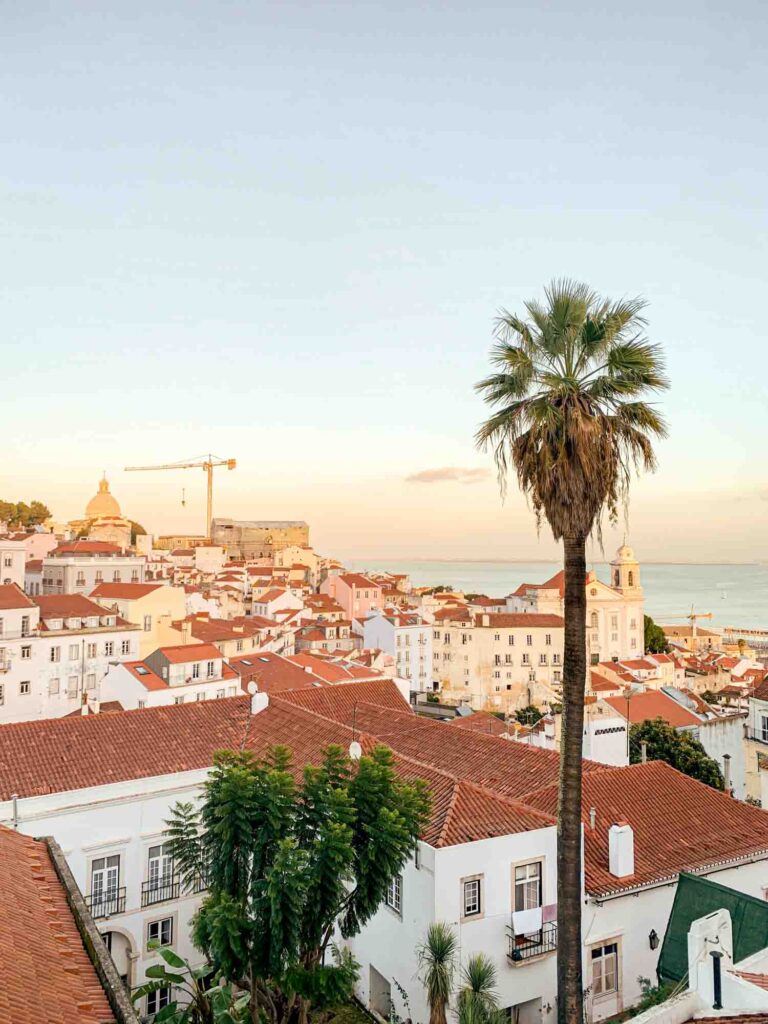
Arriving via plane: Lisbon’s Humberto Delgado Airport is located 6.5 miles (~4 miles) outside of the city center. Here are your options for getting to your accommodations:
- Metro: The most inexpensive way to get to the city center. Take the Aeroporto – Saldanha line (Red Line), which takes you to the Baixa. From here, you may have to transfer to another line to get to your accommodations. The journey takes about 20 minutes, and costs €1.65.
- Rideshare (Uber/Bolt): You can use ridesharing services to get from the airport to downtown Lisbon. Both Uber and Bolt are available in Lisbon – if you’ve never heard of Bolt, it’s an app similar to Uber but tends to be a bit cheaper. The pickup point is located outside the departures area (NOT arrivals) in Terminal 1, at the “kiss & fly” parking area. Fares fluctuate depending on demand, traffic, and distance, but tend to hover around €10-15.
- Taxi: Traditional taxis are also available and cost around €35 to get to central Lisbon. To avoid any misunderstandings, pay your fare at the taxi stand at the airport.
- Private transfer: An easy and hassle-free way to get to and from the airport, and might even be more cost effective if traveling in a small group. Your driver will meet you at arrivals in the airport, and drop you off right at your accommodations.
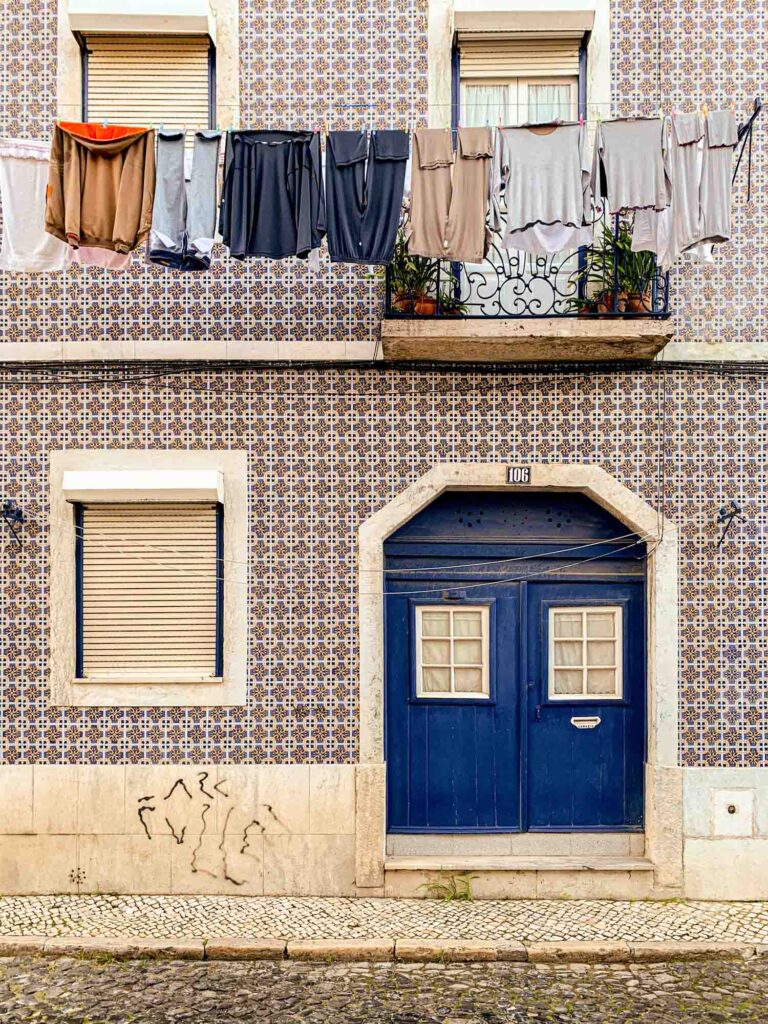

Arriving by train: If you’re taking the train to Lisbon, you will likely arrive at the city’s Santa Apolonia station. The station is located right outside the Alfama district. From here, you can connect to other parts of the city via metro, on the Blue Line. If you don’t have much luggage, you can even walk to Baixa in about 20 minutes.
The other main rail station in Lisbon is Estação do Oriente, which sits about 7 km northeast of the city center. From here, you can get to your accommodations via metro on the Red Line, or by taking a relatively expensive Uber/Bolt or taxi.
Arriving by bus: Most long distance coach buses also arrive at Estação do Oriente.

Getting around in Lisbon
- Walking: Lisbon is such a beautiful and walkable city that I mostly got around on foot. That said, the city is pretty hilly (it reminded me of San Francisco a lot), and there’s tons of cobblestoned streets so bring comfortable shoes!
- Public transit: Lisbon has a very well-connected and easy-to-use public transit system, which will get you to almost everywhere you need to go! The city has a network of buses, trams, funiculars, metro trains, and suburban trains. Pick up a reloadable Viva Viagem transit card to pay for your fares on all of the above (you’ll save a few cents as well). If you plan to rely heavily on public transportation, I recommend getting an unlimited day pass or Lisboa Card.
- Rideshares and Taxis: Lisbon is served by both Uber and Lyft, and ridesharing is an easy way to get around the city. You can take traditional taxis as well.
- Hop-on, Hop-off Tour: These hop-on, hop-off tours are a fun way to see the city and get around to all its top attractions, with local commentary to learn more about what you’re seeing! Lisbon’s version includes a bus, tram, AND boat.
Where to stay in Lisbon


For maximum convenience, I recommend staying in Baixa, Chiado, or Alfama. This will put you in close proximity to the city’s top attractions – and you’ll find plenty of accommodation options in any of these neighborhoods.
Here are some suggested places to stay in Lisbon:
- Gat Rooms Rossio: This is where I stayed (read more about my stay here), and it was the perfect home base for my Lisbon adventures! It’s got a hip, modern, and colorful vibe, at an affordable price point. There’s awesome common areas, and a free breakfast as well (which included pasteis de natas, yummmm). You also really can’t beat the location!
- Lisboa Carmo Hotel: You can’t beat the views here, which overlook the Sao Jorge Castle and the Tagus River. This 4 star property features stylishly decorated pastel colored rooms, amenities such as free water and coffee, and a perfect location near the Elevador Santa Justa.
- Alfama Lisbon Lounge Suites: Here’s an ideal option for those looking to stay in the heart of the Alfama. These apartments are elegant and modern, with a fully equipped kitchen and a 24 hour reception desk. You’ll also find views overlooking the red roofs of the Alfama and the Tagus River.
DAY 1: Lisbon (Bairro Alto, Cais do Sodre, Belem)
Your first day of this 5 day Portugal itinerary will be spent exploring some of the highlights in Lisbon. You’ll explore some of its most vibrant neighborhoods (and get a feel for the city), then spend the afternoon visiting some beautiful historic monuments in Belem. You’ll then make a stop at the hipster chic LX Factory on the way back to the city.


Morning: Bairro Alto + Cais do Sodre
Start off your morning grabbing a pastel de nata from Manteigaria (my fave – I came back at least 5 times afterward!), then exploring these two areas. Bairro Alto is one of the city’s most vibrant neighborhoods, and best known for its nightlife – but there’s a certain charm in seeing it during the day. Cais do Sodre was once the city’s red light district, but has transformed itself into one of Lisbon’s trendiest neighborhoods.
I really enjoyed wandering around in both of these areas, and just kinda taking in the vibe and getting a feel for the city. Here are some highlights that are worth pointing out:


- Calcada da Gloria: This is the street where the Elevador da Gloria funicular line operates, and it is chock full of cool murals and graffiti. The combination of the street art and funicular cars make for some fun photo ops!
- Miradouro Sao Pedro de Alcantara: Lisbon’s many hills means that there are plenty of miradouros (or viewpoints) all around the city! You’ll find two terraces and a landscaped garden here, with an expansive view of the city center and the Sao Jorge castle far off in the distance.


- Elevador da Bica (Rua da Bica de Duarte Belo): This is the best spot to snap a photo of the city’s iconic yellow trams going up the hill. You’ll need to climb up a bunch of steps, but it’s a cool view!
- Rua Nova do Carvalho (aka “the pink street”): Chances are you’ve seen a photo of this pink street as it’s quite famous on Instagram. If you think that the street was painted pink just for Instagram – it’s not! It was done as part of the revitalization project of the Cais do Sodre neighborhood. I suggest coming late morning to take photos, as you’ll want to get there after the trash is cleared out and before the tables get put out for lunch.

Lunch: Time Out Market
You must be feeling hungry from now – time for lunch! Time Out Market is the perfect stop for lunch. It’s a curated food hall that brings together all of the best eateries in the city under one roof. The concept has since taken off in several other cities (Montreal, Chicago, and NYC to name a few), but I personally think the Lisbon one is the best!
There’s dozens of options here, so there’s something for everyone! I had a delicious ceviche dish here but sadly that vendor is no longer at the market. If you already haven’t had one, I also recommend you get a pastel de nata from Mantegaria to finish off your lunch!

Afternoon: Belem
After lunch, spend your afternoon exploring the historic neighborhood of Belem, located about 7km (~4.5 miles) west of central Lisbon. It is from Belem that famous Portuguese explorers headed out for their expeditions around the world. Because of this, you’ll find plenty of museums, impressive monuments, and other beautiful historic sites to explore.
How to get to Belem: The fastest way to get to Belem is to hop on a CP suburban train from Cais do Sodre. You’ll ride for 3 stops on the Cascais train, and the trip takes less than 10 minutes. You can also take the 15E tram and get off at the Mosteiro dos Jeronimos or Largo da Princesa stop. The trip takes longer (around 30 minutes), but the trams run more frequently and are slightly cheaper.
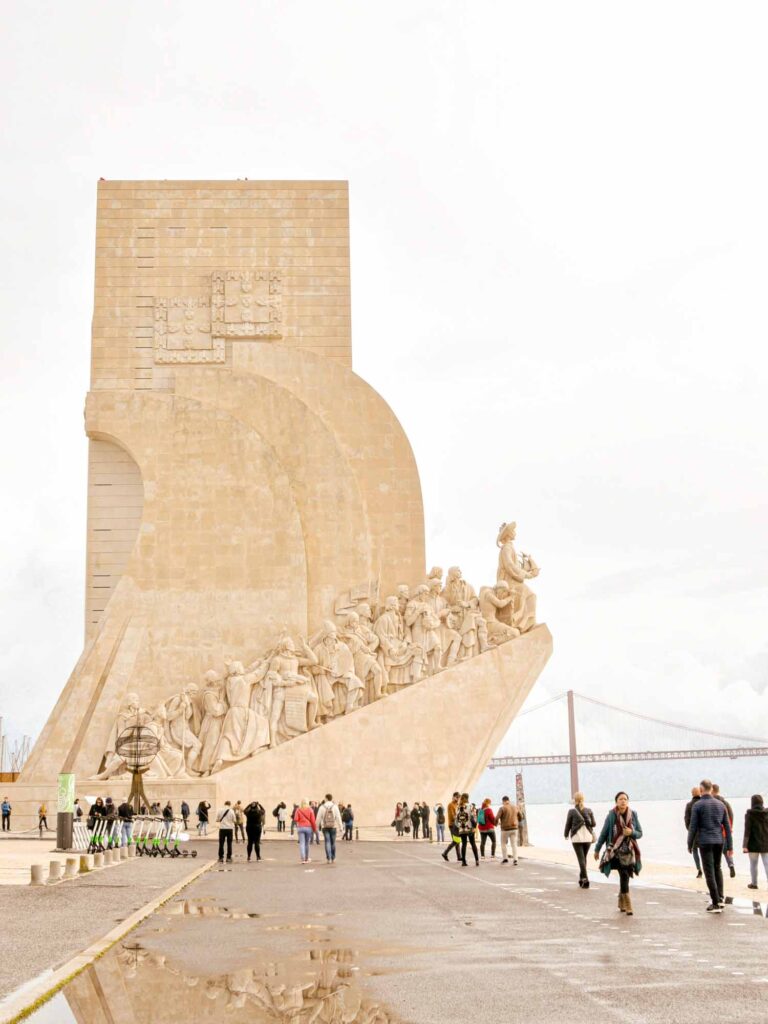

Once you get to Belem, here are my suggestions for the best things to do:
- Monument to the Discoveries (Padrao dos Descobrimentos): This enormous monument is 52 meters (170 feet) tall and commemorates 500 years of Portuguese discoveries. It’s shaped like a three-sail ship with sculptures of 32 Portuguese explorers carved into it. I’ll admit thatI wasn’t all that interested in seeing it at first but I was glad I did because it is pretty impressive – I was blown away by the sheer size and amount of detail on it! There’s also some beautiful views of the Tagus River and 25 de Abril Bridge.
- Belem Tower (Torre de Belem): Originally built as a fortress to guard Lisbon’s harbor, the Belem Tower is one of the city’s most iconic structures and one of the finest examples of Manueline architecture. It also served as a ceremonial gate, and is where Portuguese explorers took off for their voyages. You can buy a ticket to go up to the top to check out the view, but I skipped it as I heard it wasn’t that impressive. You should definitely admire it from the outside though, because it is quite gorgeous!
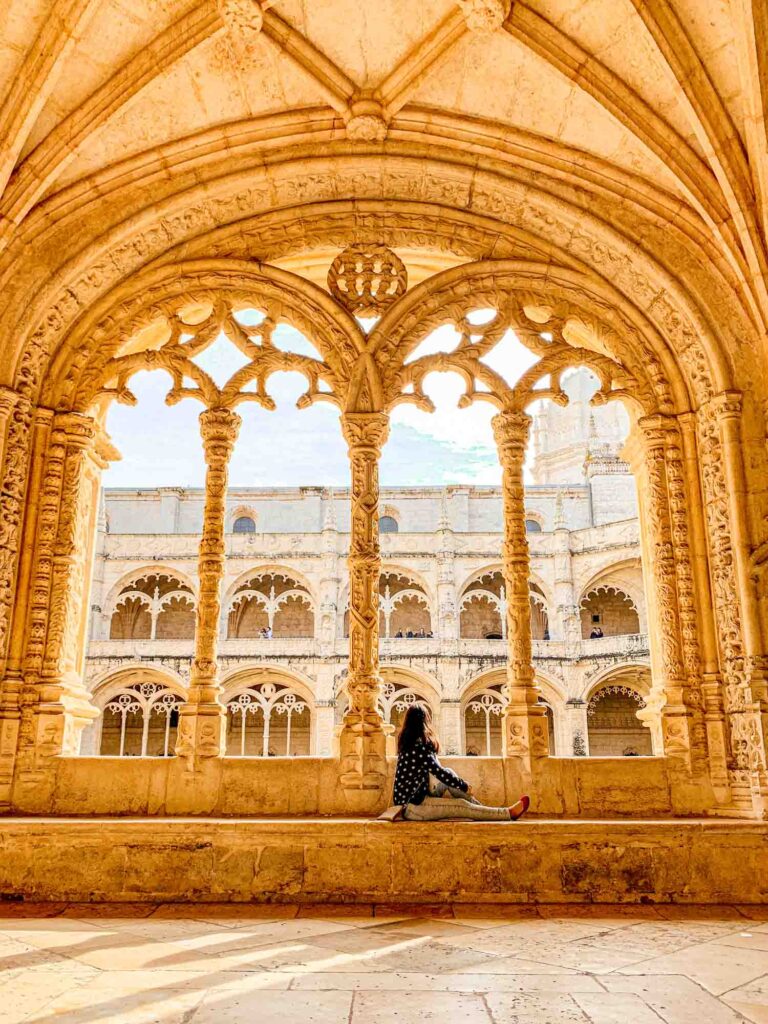

- Jeronimos Monastery (Mosteiro dos Jeronimos): The Jeronimos Monastery was one of my favorite sights during my 5 days in Portugal! Built in the 16th century, the monastery served as a place of spiritual protection for sailors and explorers. It’s another prime example of Manueline architecture, which earned it its UNESCO World Heritage site designation. The amount of architectural details here is insane – you’ll find crazy ornate spires, intricately carved stonework, and much more. The lines can get super long here, so be sure to book your skip-the-line ticket in advance!
- Pasteis de Belem: You can’t visit Lisbon and NOT try a pastel de nata…and although I’ve already talked about them a few times throughout this Portugal itinerary for 5 days, why not try one in the place they were created? The famous pastry was invented by the monks at the Jeronimos Monastery, who then sold the recipe to Pasteis de Belem, which today is still known as having one of the best in the city! You’ll likely find a LONG line outside the door here, but don’t worry – it moves super quick!
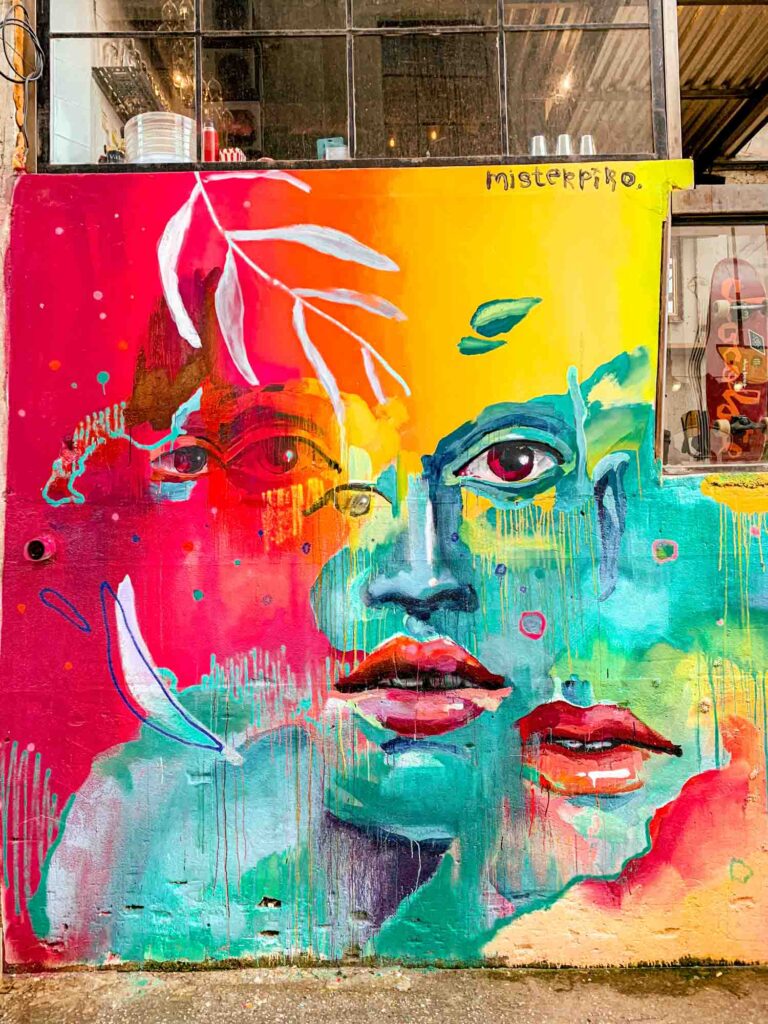


LX Factory
On your way back to the city from Belem, be sure to make a stop at LX Factory. The open-air shopping center is an absolute hipster haven – with cool murals and art installations, hip boutiques, trendy restaurants, cafes, and more.



Be sure to check out the Instagram-famous Livaria Ler Devagar bookstore (with the giant flying back hanging in front of the shelves) and get chocolate cake at Landeau (I still have dreams about it!). If you’re getting hungry for dinner, I suggest eating at 1300 Taberna, which puts a creative and fun spin on traditional Portuguese dishes.
DAY 2: Lisbon (Baixa, Chiado, Alfama)

The second day of your Lisbon and Porto itinerary will be spent exploring some of Lisbon’s most iconic neighborhoods. It will be a busy day, and you’ll get to visit some of the city’s most famous sights! You’ll be doing a lot of walking and wandering, so be sure to wear comfortable shoes.
Morning: Baixa and Chiado
These two bustling neighborhoods essentially make up Lisbon’s downtown area, and are full of historic squares, vibrant shopping streets, impressive neoclassical Pompabine architecture, and some of the city’s top attractions.


You’ll find plenty to do and see here, but here are a few spots you cannot miss:
- Rossio Square: One of the city’s main squares, dating back to the Middle Ages. It’s held major city events for over 500 years, from carnivals to bullfights, and even executions. It’s still a popular gathering place for both tourists and locals today. Be sure to check out the tile floor, which has a cool wave-like pattern! Tons of restaurants, cafes, and bars surround the square, perfect for hanging out on a sunny day.
- Elevador Santa Justa: One of the most iconic structures in the city. The lift was designed by a student of Gustav Eiffel (yes, the one who designed the famous tower in Paris!) and connects Baixa to Carmo Square. You can still take the lift to the top, but it often has a long line and isn’t worth the wait. Instead, you can get the same view by heading to Rua do Carmo, right behind the Elevador Santa Justa and heading up the passageway that will lead you to the same viewing deck at the top.
- Carmo Convent (Igreja do Carmo): Find the ruins of a 14th century church here, which used to be the largest in Lisbon until it was destroyed in the 1755 earthquake. Exploring the ruins is fascinating – it reminded me of seeing all the old churches in Antigua, Guatemala (which were also destroyed by a devastating earthquake). There’s also a small archaeological museum here.
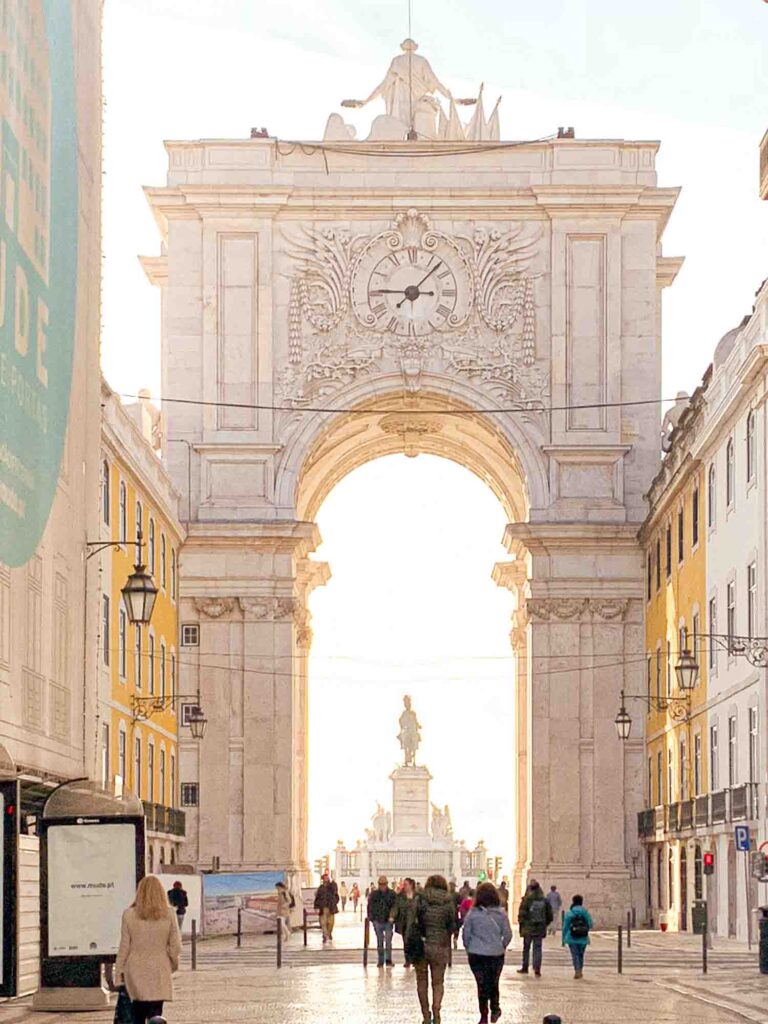

- Rua Augusta: This is the main shopping street in the city. You’ll find plenty going on at all times of the day, with terraces, live music, and street performers. There’s a mix of local and international stores here, and it’s a fantastic place to look for some souvenirs.
- Arco da Rua Augusta and Placa do Comércio: At the end of Rua Augusta is Arco da Rua Augusta, a giant stone arch that leads to Placa do Comércio, Lisbon’s largest and most famous square. It borders the waterfront of the Tagus River and is surrounded by many restaurants, offices, bars, and shops. Spend some time admiring the historic buildings here, as well as the arch – you can even climb to the top for an amazing view of the city! Do keep a close watch on all your belongings while at Placa do Comércio, as pickpockets are common here.
A note on the Line 28 tram: At this point, you’ll probably see plenty of other Lisbon itineraries recommending that you take the famous Line 28 tram to get to your next stop. However, I’d advise against it.
This is for several reasons – first, the tram is crowded AF and it is notorious for pickpockets. Secondly, many locals use the trams as a means for commuting, and the overcrowding makes it more difficult for them to get to where they need to go. Lastly – walking is more fun anyway and really gives you a feel for the city!


Afternoon: Alfama
The Alfama district is the oldest part of Lisbon, as well as its most charming. You’ll find it full of narrow cobblestone streets, pastel colored facades, hilltop miradouros, and plenty of those azulejos tiles that Portugal is famous for.
Alfama dates back to the fourth century, when it was occupied by the Romans and Visigoths. It got its current atmosphere and name when the Moors moved in in the eighth century. The web-like labyrinth of streets was originally designed as a defense system, as well as a cooling mechanism to keep homes cool in the sweltering hot summers (similar to the patios of Cordoba!). Alfama is also the only neighborhood in the city that survived the 1755 earthquake.
You can easily spend a few hours wandering through the streets here, and doing so was one of my favorite parts of my entire 5 days in Portugal itinerary. I know “getting lost” sounds a bit cliche, but that is exactly what I did here and I loved it so very much.


Still, here are a few highlights of the Alfama district that you shouldn’t miss:
- Lisbon Cathedral (Sé de Lisboa): You’ll likely pass the Lisbon Cathedral as you’re walking towards Alfama. The 12th century cathedral is the oldest church in the city and has survived a number of natural disasters. As a result, it’s been modified and rebuilt several times, and features a mix of architectural styles – Gothic, Neoclassical, Romanesque and Rococo, to name a few.
- Miradouro Santa Luzia: This beautiful miradouro features a terraced garden, as well as some impressive azulejos tiles.
- Miradouro Sophia de Mello Breyner Andresen: This might just have been my favorite miradouro in the city – the view is so expansive here! You can see all the beautiful red rooftops of the city here, and all the way out to the Tagus River and even the iconic 25 de Abril Bridge.
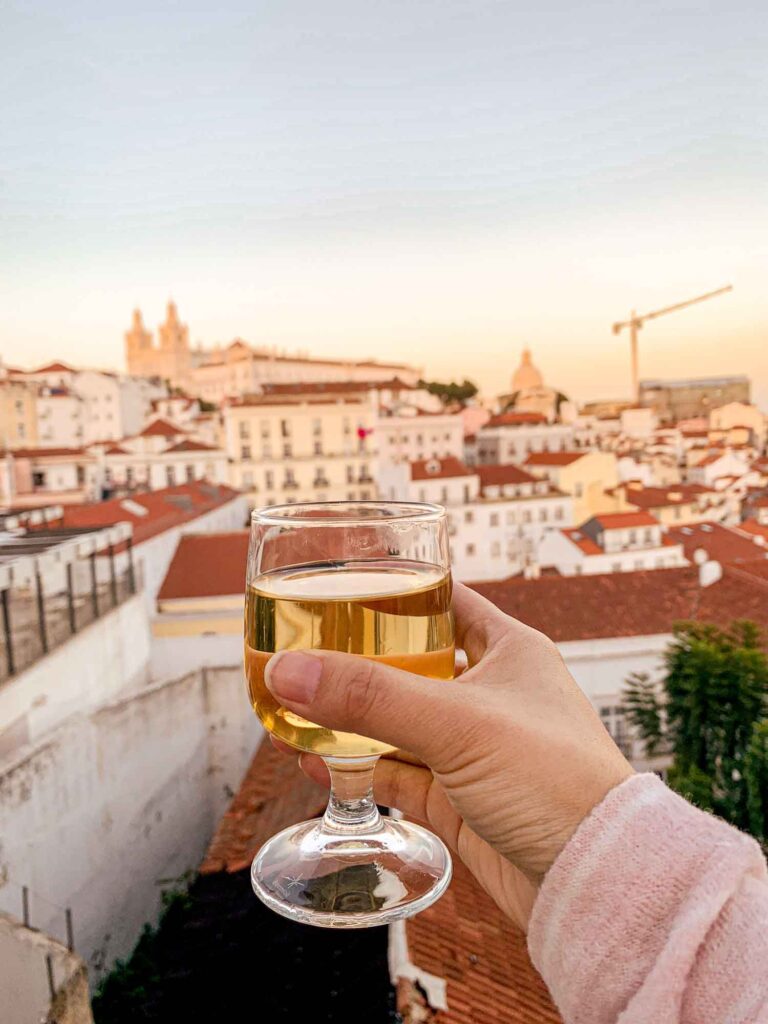

- Castelo de São Jorge: This medieval castle sits on a hill on top of Alfama, and is visible from almost everywhere in the city. You’ll find some awesome views of the city from here – although, honestly there are plenty of other places in Alfama which have equally amazing views for free. If you do end up going, be sure to buy a skip-the-line ticket.
- Sunset at Miradouro Portas do Sol: Do not miss the sunset from here – it’s a popular spot for a reason! One of my favorite memories during my 5 day trip to Portugal was hanging out here, gazing at the view, and enjoying a glass of wine as I watched the sky transform into beautiful shades of cotton candy pink and purple, then blue. Gorgeous!



Evening: Dinner and Fado Performance
Time to end the second day of your Portugal 5 day itinerary with dinner and a live fado performance! Fado is a form of Portuguese folk music that originated in the 18th century, similar to Blues, in the sense that it’s very melancholy, and full of longing and emotion.
If you wish, you can stay in Alfama for this, but I suggest heading back over to Bairro Alto.
Two of my suggestions for dinner are Taberna da Rua das Flores or Bairro do Avillez, both of which have modern takes on Portuguese food and are absolutely delicious!
You’ll find plenty of fado bars lining the streets of Bairro Alto, but I suggest going to Tasca do Chico, which was highly recommended by several sources, and was a favorite of Anthony Bourdain’s. There’s usually a long line, but they have sets of 2-3 songs every 30 minutes, so it turns over quickly!
Portugal Itinerary Day 3: Day trip to Sintra

On day 3, you’ll take a day trip to the fairytale town of Sintra! Located less than an hour away from Lisbon by train, Sintra is full of majestic palaces and fascinating historical monuments, surrounded by majestic mountains and dewy forests.
Sintra is so full of incredible sights and is so accessible from Lisbon that it is an absolute must on your Portugal itinerary for 5 days!
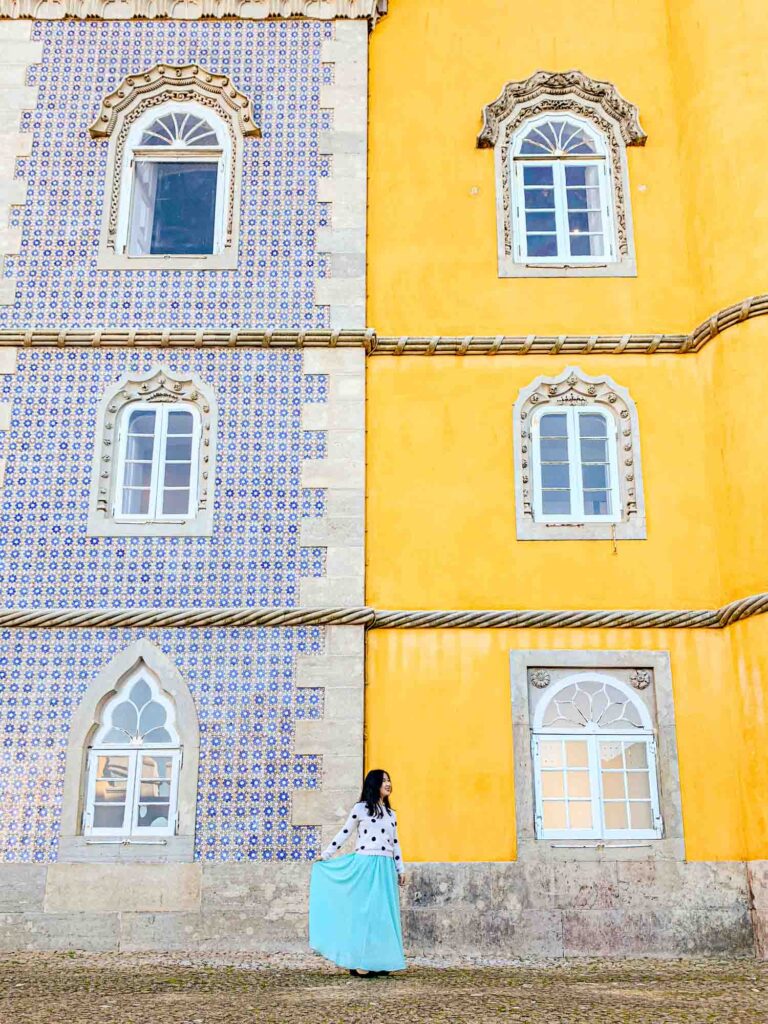

How to get from Lisbon to Sintra
Taking a train from Lisbon to Sintra is super easy! Trains depart from Rossio station in central Lisbon every 30 minutes from 6am to midnight, and the trip takes 45 minutes. The final destination is Sintra, so there’s no chance of you missing your stop, either!
The fare is €2.30 (or €4.60 round-trip), making this the most cost-effective option for getting to Sintra. If you plan on using public transportation in Lisbon later on in the day, you can also buy a CP/Metro/Carris day pass for €10.70.
If you don’t want to figure out how to get to and around Sintra on your own, consider taking a guided tour that departs from Lisbon. I like this Sintra Highlights tour, which departs from downtown Lisbon, includes round-trip transportation, and makes stops at some of the best sights in Sintra – Pena Palace, Quinta da Regaleira, and Monserrate Palace.
Taking a guided tour is also an ideal option if you are looking to also visit Cascais and Cabo do Roca (the westernmost point in Europe).


Getting around in Sintra
The palaces of Sintra are located quite a ways from each other, and the town is HILLY – therefore, walking is not recommended as a way to get around.
Instead, Sintra has a network of tourist buses operating in between the town’s top attractions. Which bus(es) you take, and the fares will depend on which monuments you are planning to visit.
You can either buy a single fare, or a “hop-on, hop-off” fare, which doesn’t include unlimited rides, but rather will let you get on and off as the bus completes its route in one direction. There’s also a day pass that allows you to ride all of the routes for €15.

Here are the two main lines that run around Sintra:
Line 434 bus (Every 15 minutes; €4.10 for single ride, €7.60 for hop-on, hop-off)
- Sintra Station
- Historic center of Sintra/National Palace of Sintra (Palacio Nacional de Sintra)
- Castle of the Moors (Castelo dos Mouros)
- Pena Palace (Palacio Nacional da Pena)
- Sintra Station
Line 435 bus (Every 25 minutes; €5 hop-on, hop-off fare
- Sintra Station
- Historic center of Sintra/National Palace of Sintra (Palacio Nacional de Sintra)
- Quinta da Regaleira
- Setais Palace (Palacio de Setais)
- Montserrate Palace (Palacio de Monserrate)
- Sintra Station
Other ways to get around Sintra include Uber/Bolt, taxis, tuktuks, or a Hop-on, Hop-off bus tour (which also includes a route that stops at Cascais and Cabo do Roca).
DAY 3: Sintra


There is a TON to see in Sintra, and it’s impossible to get to them all in one day! Someone told me that realistically, you should expect to only see 2-3 palaces in a day trip. My first thought was “no way, I travel fast” – but this ended up being true as I was pooped after my second stop and barely made it to a third.
To save time, I *HIGHLY* recommend that you book tickets to the sites you want to visit ahead of time. This is to skip the looooong lines (especially in the summer) and to avoid things selling out, particularly at Pena Palace. And speaking of Pena Palace, you’ll have to reserve a time slot ahead of time, so be sure to do that!
Here are some of the attractions you can visit in Sintra:
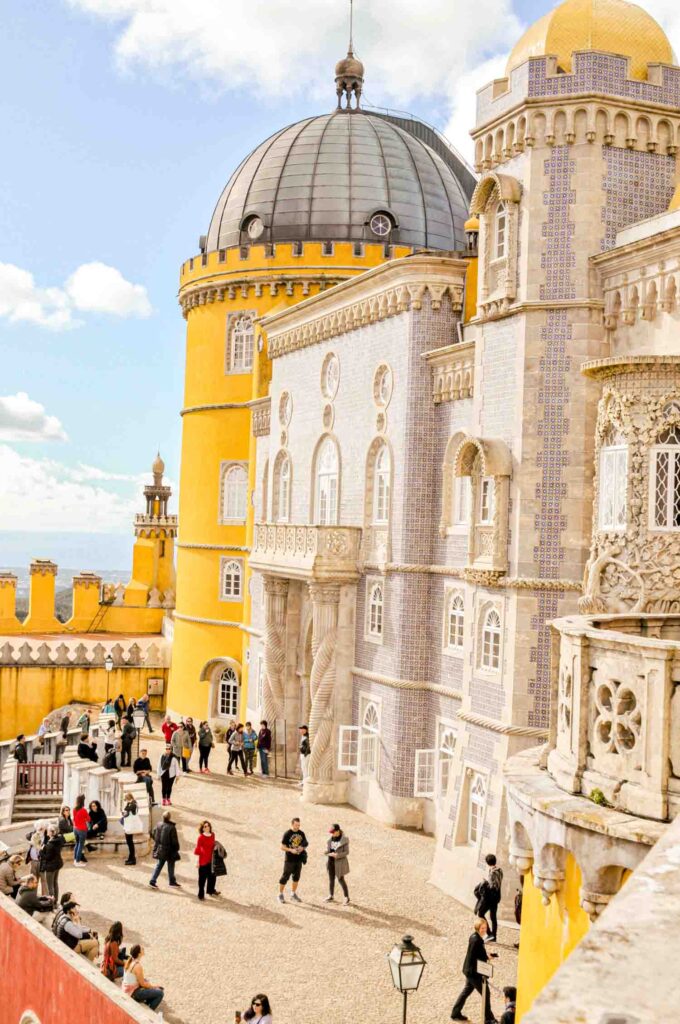

- Pena Palace: Pena Palace is *THE* highlight of Sintra, and should not be missed on your 5 day Portugal itinerary! Inspired by the iconic Neuschwanstein Castle in Germany, the castle looks straight out of a Disney movie. The brightly colored facades and Romanesque towers are quite a sight to behold! Remember, Pena Palace is the most popular attraction in Sintra so you need to plan accordingly and buy your skip-the-line tickets in advance! You’ll need to book a time slot for entry into Pena Palace, so be sure to do that in advance. I suggest either coming right at opening, or right before closing for the least amount of crowds.
- Castle of the Moors (Castelo dos Mouros): This Moorish castle is built on top of a hill and dates back to the 9th century, originally used as a military fort due to its vantage point of the Tagus River. It’s one of the most popular stops in Sintra, partially due to its convenient location near Pena Palace.


- Quinta da Regaleira: One of Sintra’s most unique attractions, Quinta da Regaleira was the sprawling estate of an eccentric man. You’ll find lush forests, ponds, secret passageways, and grand mansions here. Quinta da Regaleira is HUGE with lots of uphill walking, so keep that in mind as you explore and try not to tire yourself out (which is what ended up happening to me). The highlight here is the Initiation well – head here first!
- Monserrate Palace: I’d fully intended to visit Monserrate but tired myself out and never made it there – this is my biggest regret during my five days in Portugal. This one is a lesser visited palace since it is the furthest away from the historic center, but it is no less stunning, featuring a mix of Gothic, Arabic, and Indian architectural styles. It’s also surrounded by a gorgeous garden.
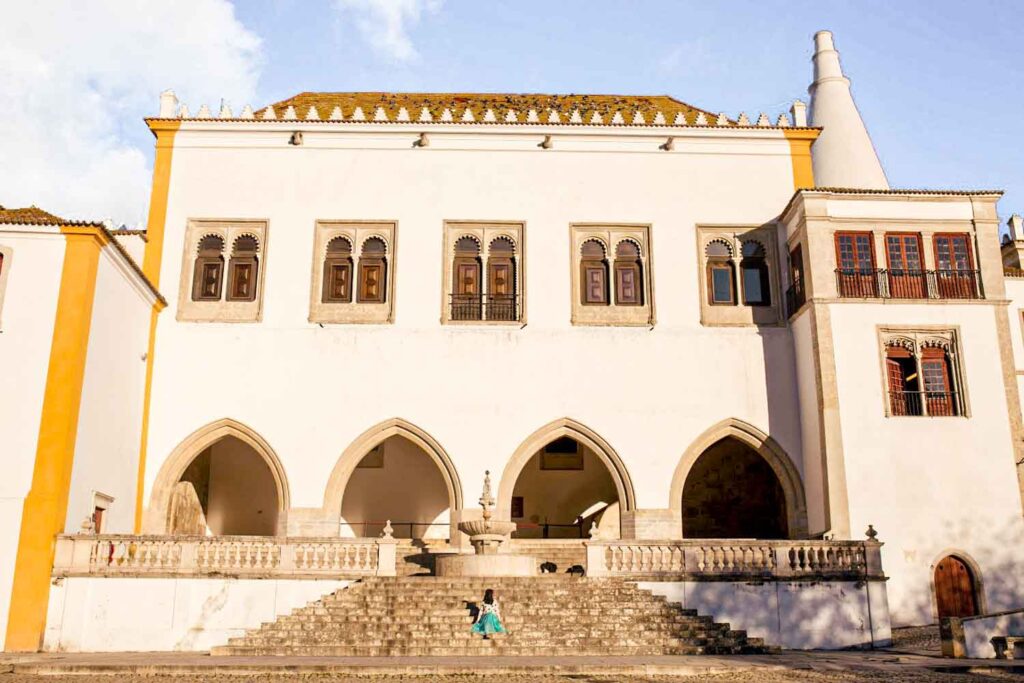
- National Palace of Sintra (Palacio Nacional de Sintra): This one isn’t the most impressive palace in Sintra, but it’s worth a quick stop since it’s so close to the historic center. The almost all-white Gothic palace dates back to Medieval times, and is the most lived-in palace in all of Portugal.
- Wander the historic center: Don’t forget to set aside some time to explore the historic center of Sintra, which is full of charming facades, quaint cobblestone streets, and stairways. You’ll find lots of cute shops, restaurants, cafes, and more. Be sure to try a travesseiros pastry from Casa Piriquita, and don’t forget to check out the cool Moorish fountain on the way out of town.
Portugal Itinerary Days 4-5: Porto


Time for the next part of your Portugal itinerary for Portugal 5 day itinerary – we’re headed to Porto!
If you thought Lisbon was charming, wait until you visit Porto. It’s hard to pick if Lisbon or Porto was my favorite, but I think Porto might *just* narrowly win out. From the moment I stepped off the train I was in love and absolutely captivated.
Porto’s got an authentically Portuguese vibe, with beautiful waterfront views, picturesque streets, azulejos tiled facades, and plenty of port wine – hey, that’s how the city got its name after all!
Spending two days in Porto is just enough time to experience exactly what makes it special, and I’m here to tell you all the best things you need to see!
Traveling to Porto from Lisbon

By train: The best way to get from Lisbon to Porto is by train. There are plenty of daily departures between Lisbon’s Santa Apolonia station and Porto’s Campanha station. Hop on the high-speed AP (Alfa Pendular) train, and you’ll arrive in less than 3 hours. You can also travel on the IC (Intercidades) trains which are cheaper but also slower.
Upon arrival at the Campanha, you can transfer onto a train that will bring you to the Sao Bento station in central Porto. This transfer is included in your ticket.
I always recommend booking train tickets on Omio to streamline the booking process, and to avoid any confusion and payment problems that come with using foreign credit cards.


By air: You can also fly from Lisbon’s Humberto Delgado Airport (LIS) and Porto’s Francisco Sá Carneiro Airport (OPO). There are multiple daily flights operated by TAP Air Portugal, which take around an hour and cost about $50 each way.
Honestly though, by the time you factor in time to get to and from the airport, going through security, waiting at the gate, and then actually flying, it takes about the same amount of time as taking the train, which to me is so much more comfortable.
From the airport, you can take the Line E (purple) metro line, which takes you to the city center in 20-30 minutes. Otherwise, you can also take a taxi, which will usually cost you around €25.
Getting around in Porto
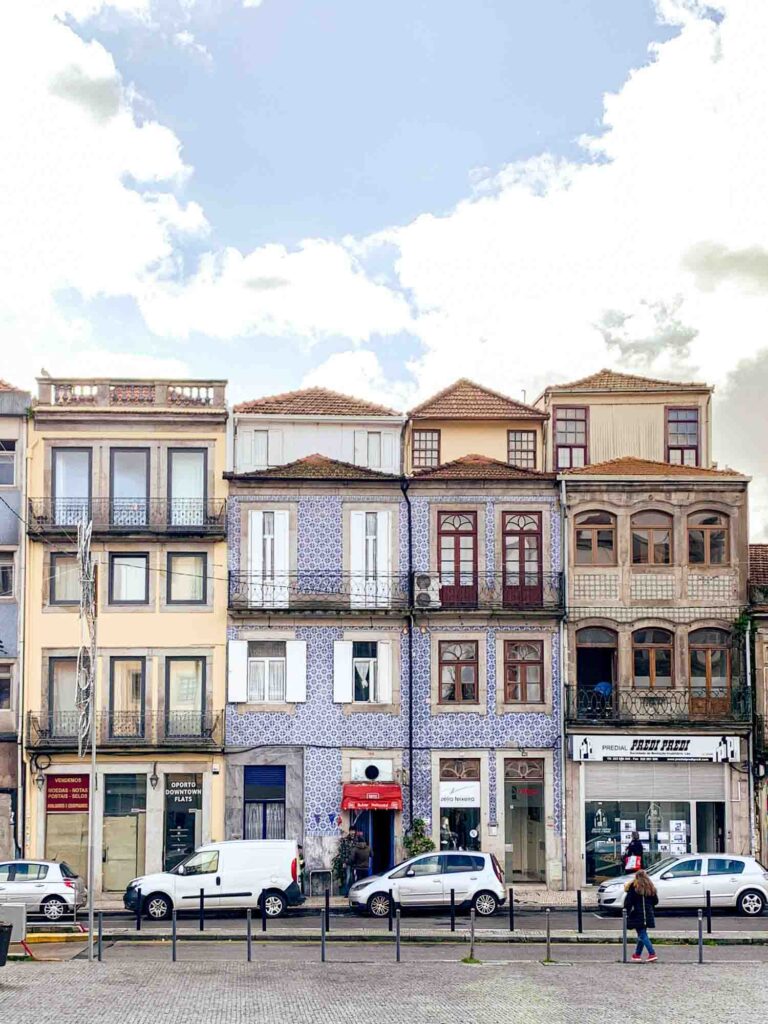
On foot: Porto’s main attractions are located pretty close to each other, and the best way to see the city is on foot. I mostly got around by walking during my time in Porto. However, do note that the city is quite hilly and there are lots of uneven cobblestone streets, so wear comfortable shoes (I recommend Rothy’s and Allbirds!)
Public transportation: If you prefer not to walk, Porto has a relatively well-connected and easy to use public transit network, which includes the metro, buses, trams, and funiculars. If you plan to use public transportation a lot, I suggest getting a Porto card.
Uber/Bolt + taxi: I used an Uber just once during my time in Porto, and found it relatively easy to use with affordable fares. You can hail a traditional taxi as well.
Where to stay in Porto
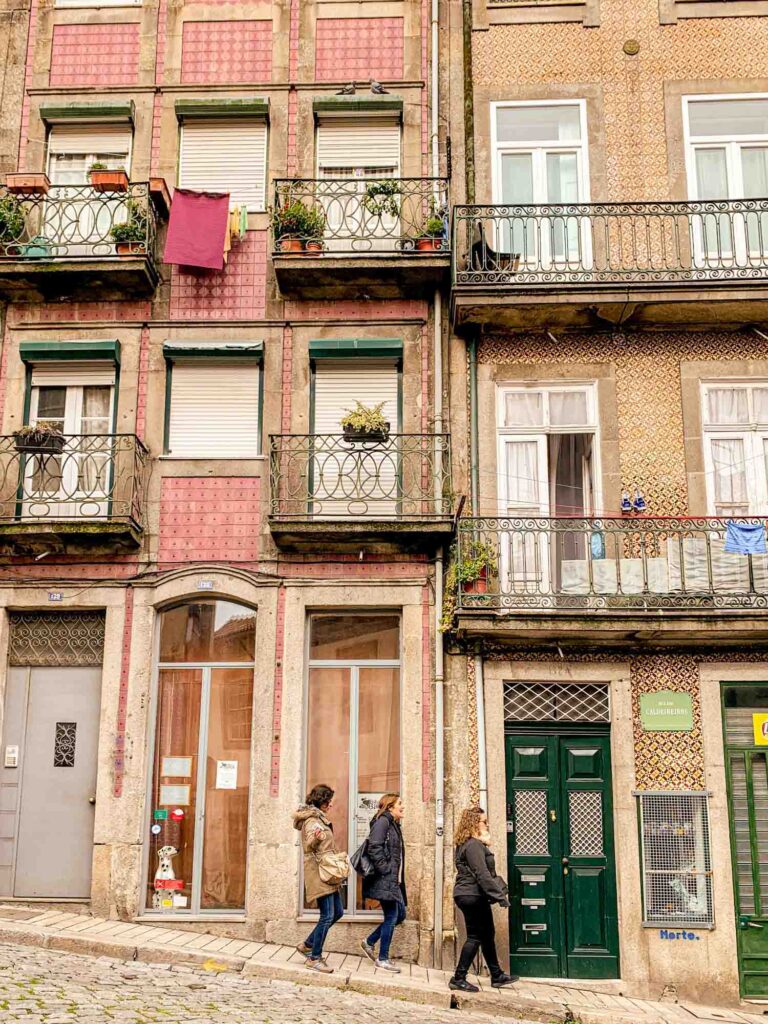

Porto’s historic center is relatively compact, so it’s pretty convenient as long as you stay within this area. Specifically, the best neighborhoods to stay in are Baixa, Ribeira, and Bolhao/Santo Ildefonso.
Here are some suggested places to stay in Porto:
- Porto Center Apartments: I stayed in an apartment here, and it was perfect – super convenient location, just a few minutes walk to almost everywhere I needed to go! It was also comfortable and had modern furnishings. Some of the apartments have a view as well! The only downside was that you have to climb up a bunch of stairs, so I would not recommend it if you have a ton of luggage.
- M Maison Particuliere: This boutique hotel has a stylish interior, with plenty of details! You’ll find elegant furnishings, chandeliers, extravagant mirrors, and more. The service here is also excellent, with an amazing staff.
- ICON Duplo Ribeira: This property has an elegant decor, with rich colors and kind of an Art Deco vibe. You’ll also be in the heart of the Ribeira district, just minutes away from the riverfront.
DAY 4: (Porto Ribeira + Vila Nova de Gaia)
On your first day in Porto, you’ll explore some of the city’s quaint historical streets, take in some incredible waterfront views, and taste some port wine. In addition, you’ll see some of the locations in the city that are said to have inspired the famous Harry Potter series.
You’ll likely arrive in Porto in the late morning or lunchtime – you’ll then have plenty of exploring to do in the afternoon!

Early afternoon: Ribeira District
On your first afternoon in Porto, spend a few hours exploring the Ribeira district. The Ribeira district is perhaps the most charming neighborhood in Porto, full of winding cobblestone streets, colorful facades, waterfront views, and plenty of azulejos tiles.
Wandering through the streets here was one of my favorite things that I did in Porto (and during my 5 days in Portugal!), and it was what helped me fall so head-first in love with the city. The streets here are so enchanting and picturesque – I literally could not stop taking photos every 5 seconds.
The Ribeira is built on one giant hill, so I suggest starting from the top and then making your way back down towards the waterfront. Either way, be sure to wear comfortable shoes because you’ll be doing lots of walking!


The best way to explore the Ribeira is to just wander around, but here are a few highlights that you shouldn’t miss:
- Take a walking tour: Highly recommended to learn more about the area’s history and culture, and to see some of the noteworthy sights! If you don’t feel like walking, there’s also a tuk-tuk tour.
- Streets you can’t miss: Rua das Flores, Rua da Bainharia, Cais da Ribeira


- Porto Cathedral (Sé do Porto):Perched on top of a hill, the cathedral looks like an imposing fortress from the outside. The inside is stunning, with barrel vaulted ceilings, a Romanesque nave, and a stunning altar. The highlight here is the 14th century cloisters, which is where you’ll see some of the best azulejos tiles in the city. Also don’t miss the view of the city from the square surrounding the cathedral.
- Palacio da Bolsa (Bolsa Palace): Bolsa Palace used to be the old Stock Exchange building, but make no mistake – this is no boring financial building. The impressive interior boasts some extravagantly decorated rooms, adorned with chandeliers, ornate carvings, elaborate sculptures, frescoes, and much more. Two of the highlights here are the Hall of Nations and the Arab Room

Dom Luis I Bridge
After exploring the Ribeira district, make your way to the other side of the river by crossing the Dom Luis I Bridge. The bridge is one of the city’s most iconic structures, featuring a towering arch and grand iron framework.
It was designed by a student of Gustave Eiffel and construction started in 1881. At the time of completion, it was the longest metal bridge in the world.
As the bridge is 60 meters tall, you’ll find some stunning views of both the Ribeira and Vila Nova de Gracia!

Late afternoon: Vila Nova de Gaia
Situated across the river from Porto, Vila Nova de Gaia is famous for one thing – port.
Port got its name because it was being shipped from Porto to the rest of Europe in the 17th century. The grapes used to make the sweet fortified wine come from the nearby Douro Valley, and it cannot be named “port” if the grapes come from elsewhere (similar to how sparkling wine cannot be named champagne unless they come from the Champagne region in France).
Even if you don’t think you’re a fan of port (I certainly didn’t), it’s still worth checking out the cellars here and doing a tasting. If anything, you’ll walk out with a newfound appreciation of the port-making process. Plus, you’ll be trying it where it was invented!


You’ll find no shortage of port cellars here, but here are a few of the best:
- Calem: This is where I did my tour and tasting, and it’s probably one of the most famous. You’ll find a number of experiences here, from a cheese + chocolate tasting, and an option that includes a fado performance.
- Graham’s: The tasting room here is known for its incredible waterfront views.
- Sandeman’s: Another popular cellar, and a good starting point if you know nothing about port.
- Taylor’s: They offer a self-guided tour.

Evening: Hang out on the waterfront
After your port tasting, spend the evening with dinner and drinks on the waterfront – either by staying in Vila Nova de Gaia or back in Ribeira.
You’ll find the waterfront on either side of the river dotted with plenty of restaurants and bars that are perfect for spending the evening. Time your dinner with sunset and you’ll also enjoy and epic view!
Here are some recommendations for waterfront spots for dinner and drinks:
- Vila Nova de Gaia: DeCastro Gaia, À Bolina, Taberninha do Manel
- Ribeira: Bacalhau, Terra Nova, Café do Cais, Wine Quay Bar
DAY 5: Porto (Baixa, Santo Ildefonso, Bolhao)
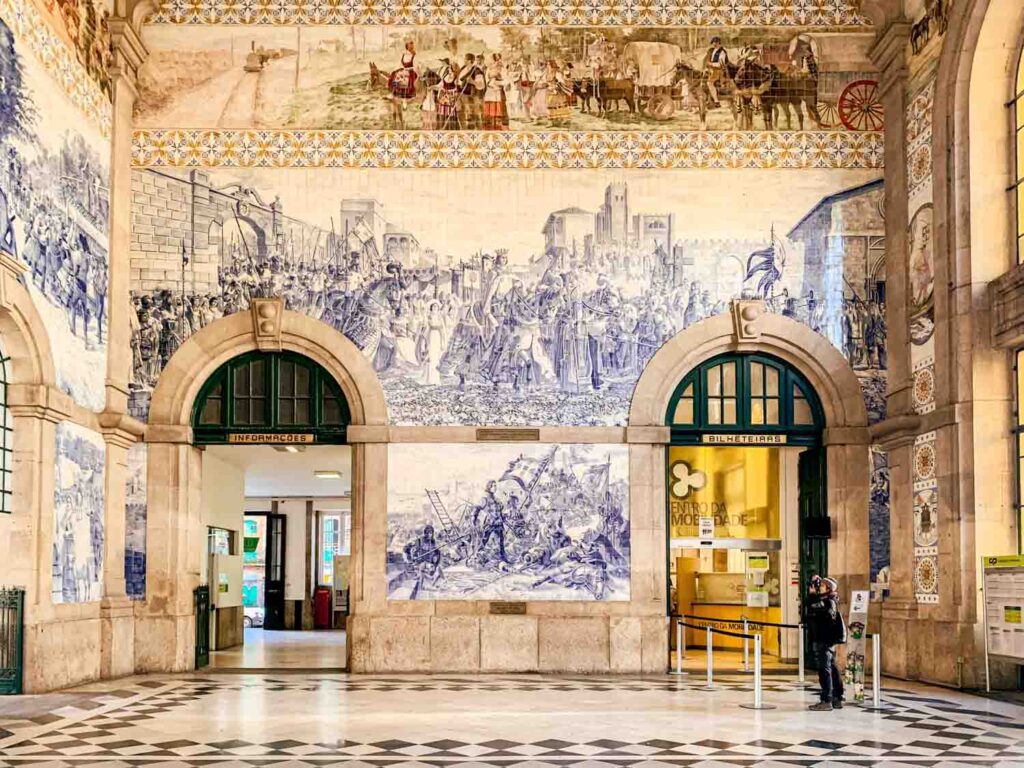
Your second day in Porto (and the last day of your 5 day Portugal itinerary *insert tear here*) will be spent exploring some of the city’s most iconic attractions in the Baixa, Santo Ildefonso, and Bolhao neighborhoods. You’ll see plenty of azulejos tiles, historic churches, and places that inspired the Harry Potter series!


Morning: Baixa
Baixa is essentially the downtown area of Porto, and you’ll find a number of historic attractions within its streets. Here are a few of them that you definitely should check out:
- Livaria Lello: This is one of Portugal’s oldest bookstores, and is famous as the supposed inspiration for Harry Potter (but it turns out that it’s actually not). The inside of the bookstore boasts stunning Art Deco/Art Nouveau architectural details, with a striking red staircase, breathtaking stained glass ceiling, and intricate wood patterns. It gets very, VERY crowded in here so if you go, go first thing in the morning! To save time, I’d also consider booking this walking tour, which includes skip-the-line access to Livaria Lello.


- São Bento Station: You may have already passed through this train station when you arrived into the city, but you need to go back to admire it in all its glory! The entryway of the station is adorned with 20,000 azulejos tiled, which depict various scenes from Portugal’s history. It is quite impressive, and absolutely stunning!
- Igreja do Carmo + Igreja de los Carmelitas: These two churches are often referred to as the twin churches, because they are connected by a narrow one meter long house. It’s another one of the best places to see azulejos tiles in Porto, and the exterior is breathtaking.


- Igreja dos Clerigos/Torre dos Clerigos (Clerigos Church and Tower): This gorgeous 18th century Baroque church stands 250 feet tall. Definitely climb the 225 steps to the top of the tower for an incredible view over the entire city! It gets super busy here, so be sure to book a skip-the-line ticket.
Indulge in a Francesinha for lunch

You’re probably feeling hungry by now, and it’s time to try a Francesinha for lunch.
What is a Francesinha (pronounced fran-se-si-nhuh), you ask? It’s one of Porto’s iconic foods, a sandwich filled with ham, sausage, steak, topped with a layer of cheese, then all smothered in a tomato-beer gravy. It usually comes served with a fried egg on top, and a side of fries for good measure.
If that sounds like a heart attack on a plate….well, you’re not wrong but it’s worth trying once in your life.
I hopped in an Uber and went to O Afonso, which is a bit outside of the city center but was highly recommended by Anthony Bourdain. If you prefer to stay in the historic center, Cafe Santiago is said to have the best.
Afternoon: Santo Ildefonso, Bolhao
Located directly north of Baixa, these two neighborhoods are full of azulejos-clad churches, historic cafes, and bustling shopping streets. It’s a bit quieter than in Baixa and Ribeira, but no less beautiful.
Here are some highlights to check out in Santo Ildefonso and Bolhao:


- Capela das Almas (Chapel of the Souls): I know there’s a ton of churches and azulejos on this 5 days in Lisbon and Porto itinerary…but the Chapel of the Souls is one of the most impressive! There are over 16,000 blue and white tiles, depicting scenes from the death of St Francis of Assisi and the martyrdom of Santa Catarina. It is quite massive with incredible detail!
- Igresia Paroquial de Santo Ildefonso: This church is perched on top of an isolated platform, which gives it a unique vertical perspective. The striking exterior is covered in thousands of azulejos tiles and depicts the life of Saint Ildefonso.
- Rua de Santa Catarina: This is Porto’s main shopping street, which has a romantic vibe. You’ll find both international stores and local boutiques here, as well as plenty of cafes, bakeries, restaurants and more. Stop at Fabrica de Nata for one of the city’s best pasteis de natas!
- Majestic Cafe: Not only is Majestic Cafe where JK Rowling hung out and wrote Harry Potter (which she confirmed in a tweet!), it’s also considered to be one of the most beautiful cafes in the world. Inside, you’ll find crystal chandeliers hanging from the ceiling, intricately carved wood fixings, and ornate mirrors, and more. Yes, prices are a bit inflated here, but it is stunning.
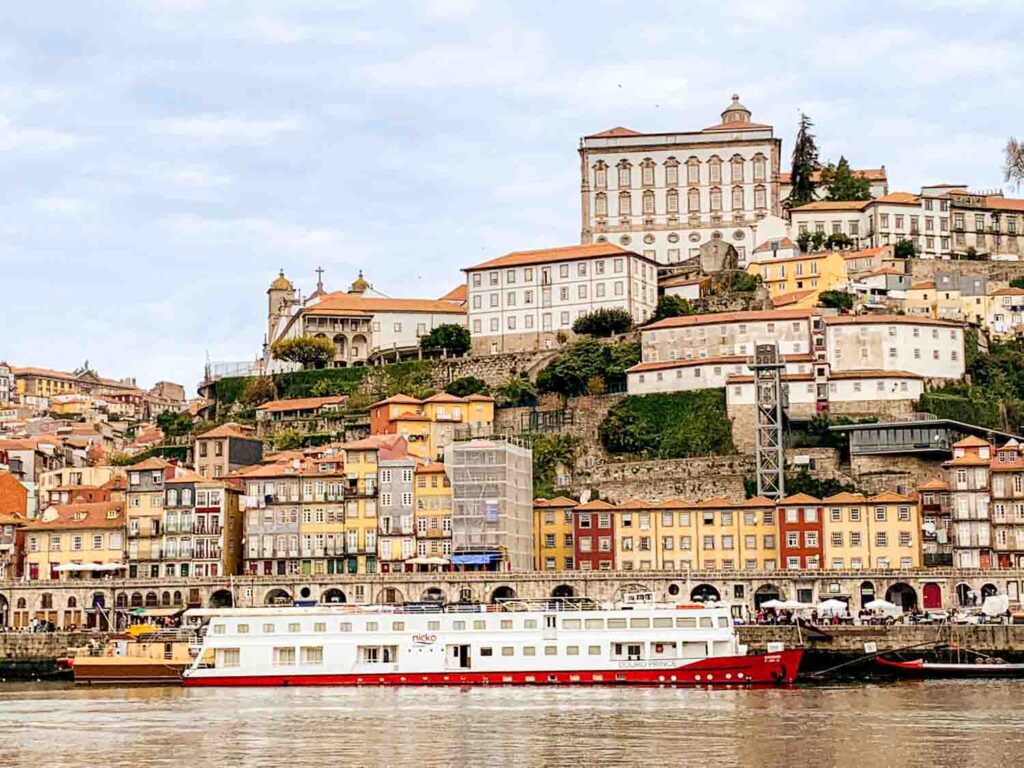
Late afternoon/evening: Six Bridges Cruise + Dinner
End your 5 days in Lisbon and Porto with a relaxing cruise on the Douro River! I always love seeing cities from the water, so I love doing sightseeing cruises (some of my favorites were in Stockholm and Chicago). It’s the perfect activity to see the city, but relax and rest your feet for a bit (which will probably be welcome after all the walking you did on your Portugal 5 day itinerary!)
I recommend taking the Six Bridges cruise, which sails through the Douro River and gives you some incredible views of the historic center of Porto, Vila Nova de Gaia, as well as the unique experience of sailing under the bridges that surround the city, all while learning about the bridges themselves and the history of Porto.
For dinner afterwards, I suggest eating back in Baixa or Ribeira. Two recommended places that I really enjoy are Tapabento (be sure to make a reservation ahead of time though!), and Cantinho do Avillez, both of which serve up Portuguese food with a twist.
Have you ever been to Portugal? What would you include on your Portugal itinerary for 5 days?
More Portugal content you may enjoy:
The Perfect 3 Days in Lisbon Itinerary
An Amazing Weekend in Porto
A Fairytale Day Trip to Sintra
Liked this post? Save this 5 days in Portugal itinerary to Pinterest for later!


Caroline is a Southern California based traveler, writer, and photographer. She travels all around California, the US, and the world in search of the most colorful places, the most delicious food, and bucket-list adventures. Her aim is to inspire other travelers discover how to add more adventure and joy to their lives. On Pictures & Words, you’ll find detailed guides + itineraries, along with vibrant photos to help you plan the the most epic trips. When she’s not traveling, Caroline also runs half marathons.
